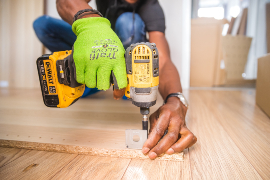스포트라이트
주방 설치자, 목공 설치자, 목공 설치자, 캐비닛 설치 기술자, 가구 설치자, 인테리어 시스템 설치자
수납장이 없는 집에 산다고 상상해 보세요! 모든 유리잔, 접시, 식기, 냄비와 프라이팬, 미리 포장된 음식, 기타 물품이 바닥이나 상자에 쌓여 있을 것입니다. 이런 상상을 해보면 수납장 설치기사가 얼마나 중요하지만 간과되는 직업인지 깨닫게 될 거예요!
캐비닛 설치는 모든 종류의 건물에 캐비닛을 정확하고 안정적으로 배치하는 숙련된 작업입니다. 설치자는 캐비닛 제작자처럼 캐비닛을 설계하거나 제작하지는 않지만 프로세스의 가장 중요한 마지막 단계인 실제 설치를 담당합니다.
캐비닛 설치 담당자는 디자이너, 건축가, 고객과 협업하여 정확한 설치 요구 사항을 파악하는 경우가 많습니다. 이를 통해 미리 계획을 세우고 현장에서 필요한 조정을 할 수 있습니다. 또한 다양한 설치 기술을 숙달하고 다양한 수공구, 전동 공구 및 자재를 사용할 수 있어야 하며 캐비닛이 정확하고 안전하게 설치되도록 보장할 수 있어야 합니다.
- 생활 공간에 기능 추가
- 다양한 프로젝트에 참여할 수 있는 기회
- 신축 및 리노베이션 프로젝트에 대한 꾸준한 서비스 수요
근무 일정
캐비닛 설치 담당자는 일반적으로 풀타임으로 근무하며 작업 현장으로 자주 출장을 가야 합니다. 대규모 프로젝트에서 건설 팀과 협업할 때는 초과 근무를 할 수도 있습니다.
일반적인 의무
- 필요에 따라 고객과 만나 프로젝트 범위, 세부 사항, 기간 및 예산을 검토합니다.
- 자재, 인건비 등의 비용을 기준으로 견적을 작성합니다. 질문에 응답하거나 설명 제공
- 고객 검토, 승인 및 서명을 위한 공식 계약서 공유
- 설치 청사진, 계획 및 필요한 하드웨어를 읽고 해석합니다.
- 설치 장소를 철저히 측정하고 준비하세요. 설치 공간의 치수를 확인하여 캐비닛이 설계대로 맞는지 확인합니다.
- 배관 설비, 조명, 문, 가전제품 등을 고려하세요.
- 캐비닛을 설치하여 수평이 맞고, 안전하고, 올바르게 정렬되었는지 확인합니다. 완벽한 맞춤을 위해 현장에서 캐비닛을 조정하거나 수정합니다.
- 설치 시 다양한 도구를 사용하여 측정, 절단, 고정하기
- 수공구를 사용하여 하드웨어(예: 경첩, 손잡이, 걸쇠 또는 서랍 당김 장치)를 설치합니다.
- 필요하고 자격을 갖춘 경우 설치된 캐비닛에 터치업을 적용합니다.
- 설치 프로세스 전반에 걸쳐 고객, 디자이너 및 시공 팀과 협력합니다.
- 설치 후 작업장 청소, 장비 및 도구가 실린 차량의 사업장 복귀
- 고객에게 청구서를 제출하여 결제하고, 분쟁이나 불일치에 대응하세요.
추가 책임
- 모든 장비와 도구에 대해 설명합니다. 필요에 따라 정기적인 유지보수 또는 수리를 수행합니다.
- 필요한 경우 새 장비, 도구, 하드웨어 또는 기타 소모품을 주문하세요.
- 설치 및 사용된 자재에 대한 정확한 기록 유지
- 안전 표준을 준수하여 안전한 작업 환경 유지
- 최신 설치 기술 및 도구를 포함하도록 기술을 지속적으로 업데이트합니다.
소프트 스킬
- 정확도
- 분석
- 비즈니스 중심(자영업자의 경우)
- 고객 서비스
- 세부 지향적 인
- 뛰어난 손과 눈의 협응력
- 수동 손재주
- 심각한 먼지 알레르기 또는 호흡 문제 없음
- 끈기
- 인내
- 문제 해결
- 프로젝트 관리
- 품질 보증
- 안전 지향적 인
- 건전한 판단과 추론
- 강력한 의사 소통 기술
기술 능력
- 건설 회사
- 주택 건설 회사
- 독립 계약자
- 리노베이션 및 리모델링 회사
- 설치 서비스를 제공하는 소매점
- 자영업자
캐비닛 설치는 정밀한 작업입니다. 설치자는 시간을 들여 꼼꼼하게 계획을 세우고 처음부터 올바르게 작업을 완료해야 합니다. 정확한 측정, 천장 높이 계산, 적합한 하드웨어 가져오기, 기존 배관 주변 구축, 도어 간섭 고려, 캐비닛이 조명에 미칠 영향에 대한 계획 등 고려해야 할 사항이 무수히 많습니다.
추적해야 할 모든 작업 외에도, 특히 하루 일과가 길어지면 육체적으로도 힘든 작업이 될 수 있습니다. 하지만 오류의 여지가 거의 없기 때문에 설치자는 지름길을 택할 수 없습니다.
완성된 프로젝트가 완벽하지 않으면 다시 와서 문제를 해결해야 할 수도 있습니다. 그렇지 않으면 환불을 해야 하거나, 비즈니스 평판이 손상될 위험이 있거나, 심지어 소액 청구 소송에 휘말릴 수도 있습니다.
캐비닛 디자인에 기술을 통합하는 것은 점점 더 증가하는 추세로, 캐비닛 설치 및 사용 방식을 변화시키고 있습니다.
최신 설치 시설에는 내장형 충전 스테이션, 센서로 작동하는 조명, 고급 소프트 클로징 메커니즘이 포함되는 경우가 많습니다. 이러한 추가 기능으로 인해 설치자는 이러한 구성 요소와 기술 기능을 최신 상태로 유지해야 합니다.
또 다른 트렌드는 캐비닛 제작 시 친환경적이고 지속 가능한 소재에 대한 수요입니다. 캐비닛 설치자는 점점 더 재활용 재료, 대나무 및 저-VOC 마감재로 작업하고 있습니다. 설치자는 캐비닛을 직접 만들지는 않지만 이러한 재료를 올바르게 다루는 방법을 알아야 합니다.
또한 맞춤형 캐비닛을 선호하는 추세로 인해 설치자는 비표준 크기로 인해 설치 방식에 좀 더 창의성을 발휘해야 합니다.
어렸을 때 캐비닛 설치 담당자는 실습 활동에 대한 선호도를 보일 수 있습니다. 목공, 공예, 모형 만들기를 즐겼을 수도 있습니다. 또한 가재도구를 수리하거나 가벼운 목공 작업을 하는 등 집안일을 매우 능숙하게 처리했을 수도 있습니다. 또한 일반적으로 매우 체계적이고 훌륭한 계획가이기도 합니다!
- 캐비닛 설치자는 고등학교 졸업장 또는 이와 동등한 학력이 필요합니다. 대학 학위는 필요하지 않습니다.
- 설치자의 약 17%가 학사 학위를 취득하지만, 자영업자인 경우 비즈니스 기술을 연마하고 싶어서 학사 학위를 취득하는 경우가 많습니다.
- 근로자는 해당 목공, 목공, 목공 또는 건축 기술을 보유하고 있어야 합니다. 이러한 기술은 고등학교 수업, 직업 또는 기술 학교 과정, 견습직, 아르바이트 또는 이러한 것들을 조합하여 배울 수 있습니다!
- 일부 설치자는 도우미 또는 인부로 시작하여 설치 및 피팅 기술, 하드웨어 설치, 접착제 도포, 서랍 슬라이드 설치, 레이아웃 및 마킹 기술, 청사진 읽기, 수공구 및 전동 공구의 안전한 사용법을 배우게 됩니다.
- 캐비닛 설치는 비즈니스이므로 작업자에게는 고객 서비스 기술, 비즈니스 기술 및 일반적인 문제 해결 기술도 필요합니다.
- Zippia에 따르면 캐비닛 설치자가 되려면 약 6~12개월의 직무 교육이 필요합니다.
- 안전은 이 직업에서 필수적인 부분이므로 OSHA 안전 및 보건 기초 자격증 또는 OSHA 10시간 교육 카드가 도움이 될 수 있습니다. 고용주는 일반적으로 자세한 내용을 설명하고 근로자의 가입을 도와줄 수 있습니다!
- 캐비닛 설치자는 일반적으로 운전 면허증이 있어야 작업 현장에 갈 수 있습니다.
- 캐비닛 설치자는 대학에 진학할 필요는 없지만, 수업을 듣는다면 수업료, 할인, 지역 장학금 기회(연방 지원금 외에)를 고려하세요.
- 캠퍼스 내, 온라인 또는 하이브리드 프로그램에 등록할지 여부를 결정할 때 자신의 일정과 유연성을 고려하세요. 다음과 같은 가구 디자인 과정은 가능한 한 많은 실습을 하는 것이 가장 이상적입니다.
- 이전 수강생들의 후기를 읽고 프로그램 동문 네트워크에 대한 취업 통계 및 세부 정보를 확인하세요.
- 일부 교육 프로그램은 현지 고용주와 연계되어 있을 수 있습니다!
- 캐비닛 설치자는 영어, 미술/디자인, 청사진 읽기, 일반 수학(산술, 분수, 소수, 비율, 비율), 기하, 물리학, 제도, 컴퓨터 지원 설계, 목공 또는 상점 과정을 수강해야 합니다.
- 수공구 및 전동 공구의 안전한 사용법을 알려줄 수 있는 전문가의 감독 하에 실습 기술을 익히세요.
- 고등학생은 커뮤니티 칼리지 또는 직업 훈련 수업을 동시에 수강할 수 있는 경우가 많습니다. 학교 카운슬러가 자세한 정보를 제공할 수 있을 것입니다.
- 목공 또는 건설 아르바이트(또는 견습 또는 초급 노동자 직책)를 통해 실질적인 업무 경험을 쌓으세요.
- 차고에 있는 캐비닛을 이용해 연습해 보세요.
- 지역 해비타트 프로젝트에 자원봉사를 고려하세요.
- 온라인 강의를 통해 실무 지식을 넓혀보세요!
- 이 오래된 집과 같은 YouTube 채널에서 관련 동영상 보기
- 수납 관련 서적, 잡지, 블로그, 토론 포럼을 통해 스스로를 교육하세요.
- 현직 캐비닛 설치자에게 정보 제공 인터뷰를 할 시간이 있는지 물어보세요.
캐비닛 설치 등 숙련된 직종의 많은 고용주는 고용 전 약물 검사를 실시한다는 점에 유의하세요. 수공구 및 전동 공구의 사용은 위험할 수 있으므로 고용주와 보험 회사는 위험을 줄이고자 하기 때문입니다. 수습직의 경우, 노조는 수습 전 약물 검사 또는 무작위 약물 검사를 의무화할 수 있습니다.

- 학교나 자원봉사, 아르바이트, 견습생 등을 통해 관련 경험을 최대한 많이 쌓으세요.
- 글래스도어, 인디드, USAJOBS, 심플리히어드와 같은 채용 포털을 확인하세요.
- Apprenticeship.gov에서 수습 기회를 찾아보세요.
- 이력서, 모의 면접, 구직에 대한 도움을 학교의 직업 서비스 담당자에게 요청하세요. 수습직을 제공하는 지역 노조와 연결되어 있을 수도 있습니다!
- 조합 수습직에 지원하는 경우, 신청서를 작성하기 전에 신청 지침을 자세히 읽어보세요.
- 인디드는 "대부분의 노조는 수습직을 지원할 때 지원자가 해당 업계의 전문가가 되기를 기대하지 않는다"고 지적합니다.
- 네트워크에 연락하여 기회를 찾고 있음을 알리세요.
- 구인 광고를 신중하게 검토하여 요건을 충족하는지 확인합니다.
- 이력서를 관련 업무 및 학업 경험에 집중하세요.
- 이력서/지원서에 다음과 같은 키워드를 포함하세요:
- 블루프린트 읽기
- 캐비닛 제작
- 목공
- 고객 서비스
- 디테일 지향
- 수공구
- 몰딩
- 전동 공구
- 리모델링
- Saw
- 목공 트림
- 온라인 포럼에 참여하여 커리어 조언을 구하세요.
- 교수, 감독자 및 동료에게 개인 참조 자료로 봉사 할 것인지 물어보십시오.
- 캐비닛 설치 관리자 이력서 템플릿을 검토하여 서식과 문구에 대한 아이디어를 얻으세요.
- 중요한 면접에 대비하기 위해 자주 묻는 면접 질문을 찾아보세요.
- 성공적인 면접을 위해 항상 적절한 복장을 갖추세요!
- 채용 전 요구 사항을 충족할 수 있도록 준비하세요.
- 캐비닛 설치자는 일관되게 고품질의 작업을 수행하고, 세부 사항에 주의를 기울이고, 매일 정시에 준비하고, 시간과 예산에 맞춰 프로젝트를 완료함으로써 승진을 도모할 수 있습니다.
- 상사와 경력 목표에 대해 이야기하세요. 전문 자격증 등 고용주가 제안하는 모든 교육에 참여할 의향이 있음을 상사에게 알리세요.
- 업계에 대해 계속 배우면서 비용을 충당할 수 있도록 학비 환급 또는 기타 고용주가 후원하는 교육 혜택에 대해 문의하세요.
- 항상 안전을 우선시하고 지름길을 택하지 마세요. 한 번의 심각한 사고나 부상으로 커리어 전체가 손상될 수 있습니다!
- 더 복잡한 프로젝트에 도전하세요
- 신입 설치 관리자 및 기타 후배 직원들을 감독하고 멘토링하세요. 솔선수범하세요!
- 전문가 조직에 적극적으로 참여하여 새로운 것을 배우고 네트워크를 넓혀보세요.
- 필요한 경우, 더 많은 승진 기회를 제공하는 직무에 지원하거나 자신의 사업을 시작하세요.
웹사이트
- Apprenticeship.gov
- 관련 건축업자 및 계약자
- 미국의 관련 일반 계약자
- 제조 기술 협회
- 무역 여성 기술로 뛰어난 기회와 연결하기
- 커리어 연결
- 카펜터스 사우스웨스트 관리 공사
- 목수 교육 기관
- 하드햇에 헬멧
- 홈 빌더 연구소
- 직업 군단
- 전국 리모델링 산업 협회
- 전국 건물 무역 연합
- NCCER
- 형제단의 자매
- 미국 목수 및 소목공 연합 형제단
- 미국 목수 및 소목공 연합 형제단, 목수 훈련 기금
- 서부 주 목수
- 목재 산업 리소스 협업
- 북미 목공 직업 연합
- 목공 기계 산업 협회
책
- 주방 캐비닛 만들기: Taunton의 BLP: 시작부터 끝까지 전문가의 조언, Udo Schmidt 작성
- 주방 캐비닛 만들기(기본으로 돌아가기), 스킬 인스티튜트 프레스 제공
- 간단하게 만드는 주방 수납장 설치, 작성자: Gregory Paolini
최근에는 캐비닛 제작이 점점 자동화되고 있지만 실제 설치 프로세스가 자동화되기까지는 오랜 시간이 걸릴 수 있습니다. 그렇기 때문에 앞으로도 캐비닛 설치 전문가에 대한 수요가 꾸준히 유지될 것으로 예상됩니다.
하지만 다른 옵션을 탐색하고 싶으시다면 아래에서 관련 직업을 고려해 보세요!
- 건물 유지 보수 작업자
- 목수
- 건설 및 건축 검사관
- 건설 노동자
- 건식 벽체 설치 관리자
- 바닥재 설치 관리자
- 가구 어셈블러
- 홈 인스펙터
- 단열 작업자
- 모델 설치 관리자
- 리노베이션 전문가
- 루퍼
- 태양 광 설치 프로그램
- 구조용 금속 제작자 및 피팅
- 타일 및 석재 세터
- 목공 기계 세터
뉴스 피드

주요 채용 정보

온라인 과정 및 도구







